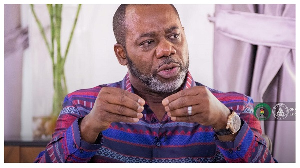..... Through the Presentation of a False “Family Tree”
In a publication on Ghanaweb by a principal member of the Kumawu Ankaase family, on Tuesday 7 April 2015, titled, "Kumawu chieftaincy affairs: the true picture", one could see the writer rather ingloriously bashing his perceived opponents. In his verbose explanation of events, all in attempts to rubbish the claims by the supposed destooled Kumawu sub-chiefs by the purportedly enstooled Kumawuhene (Dr Yaw Sarfo), he was in praise of an Ankaase Family Tree drawn up by Barimah Kwame Afram, the late ex-Kumawuhene.
I have reproduced below the said "Ankaase family tree" exactly as found in page 235, Fig.50 of The Law and Constitution of Ashanti by R.S. Rattray, an anthropologist appointed by the colonial administration (Governor Guggisberg) to find out about "the history of the Sika Agua Kofi (the Golden Stool) and anything in connection with the subject..."
To start with, the Ankaase family members are not true royals as falsely claimed, let alone, being of same matrilineal descent as Barimah Tweneboah Koduah I, the originator of the Kumawu Koduah Stool. Therefore, the underlying family tree in which Barimah Kwame Afram sought legitimacy for his matrilineal ancestors, himself, and his descendants is not genuine but fake. The Ankaase family members were never descended from Seni Fonton but rather, from one AYOO, an alleged Fulani succulent damsel bought, and brought over to Kumawu Palace as a slave.
It hurts to tell the truth but in the end it brings comfort. I will normally not narrate this history for the simple fact that I am friends with some of the Ankaase family members. They will surely feel more pain to see their own friend reveal their ancestry. However, for the purposes of setting the records straight, and for the sake of upcoming historians and lovers of history, I am obliged to give the correct, but not the fake, account of Kumawu history, especially, that pertaining to the origins of our Kumawu chieftaincy.
From the write-up which I shall be rebutting fully at the appropriate time, the writer said, "The ex-Aduanahene will be the first to admit as a witness before the Asanteman which he so much dislikes that since the reign of Otumfuo Osei Kwadwo, the Odumase branch of the Kodua royal family which the ex-Aduanahene is a principal member, have been banned from occupying the Kodua stool of Kumawu. The notorious fact is that Barima Akwatra Feni the then Kumawuhene and the great ancestor of the ex-Aduanahene, in 1774 exhibited cowardice in the war between Asante and Banda hence the ban on the descendants of Barima Feni's lineage which the prohibition has perpetually endorsed by the Asanteman".
"The brilliant and excellent presentation of the Ankaase Family tree supported by the Genealogy of chiefs and Queen mothers of Kumawu as in page 235 of Rattray earned him the title of Professor by the Asanteman."
From the footnote as read under the fake Ankaase family tree, a true copy form of which is reproduced below, same as found in Rattray's book, it reads, "The descendants of Akosua Hema, alias Dwumo are known as the Anenenya branch of the royal house; those descended from Etai Akyeampong are known as the Abira or Apebiakyere line. I was informed that in the time of Kobina Kodia, the Elders of Kumawu drank the gods that the chiefs of Kumawu should be selected from this line. Kwaku Boaten's name naturally does not appear on the genealogical table"
In Rattray's book, Akwatra Feni, then chief of Kumawu was destooled for being a coward during the Banda war. However, the Ankaase writer, Nana Kwame Afram alias Dr James Charles London, once granted a radio interview to Peace FM, Accra, in which he asserted that "Nananom drank the gods to banish Akwatra Feni, the great ancestor of the ex-Aduanahene, and his family lineage from ever ascending to the Kumawu paramount throne for being uncouth towards Nananom and Ashanti traditions and custom, same as the ex-Kumawu Aduanahene is doing towards Asantehene, the Overlord of Asanteman". This same writer in same breath is saying, Akwatra Feni was destooled and subsequently banned along with his matrilineal family from ever occupying the stool for displaying acts of cowardice".
Which of his two versions do we accept, as COWARDICE and UNCOUTH are two different words with different meanings.
COWARDICE means lack of bravery. A coward is a person who is not brave and is too eager to avoid danger, difficulty, or pain while UNCOUTH is behaving in a rude, unpleasant way.
Going forward, let me seize this opportunity to inform the public of how the great ancestor of the Ankaase family (Yaw Dabo), maliciously collusively ascended to the Kumawu Koduah Stool as a regent. A regent is traditionally appointed by the locals but in the case of Yaw Dabo, he was imposed on Kumawu by his brother-in-law, Otumfuo Osei Yaw Akoto, then Asantehene.
Who is a regent? A Regent is a person who rules a country only for a limited period, because the king or queen is absent or too young, too ill, etc.
Yaw Dabo was the son of AYOO as Yaa Mansah was her daughter. Therefore, Yaw Dabo and Yaa Mansah were siblings. "Okomfo" Yaa Mansah got married to then Asantehene Otumfuo Osei Yaw Akoto. During the reign of Otumfuo Osei Yaw Akoto, from about 1824 to 1838, it did occur that he strongly intended to amass, or amassed Asante Confederacy troops against Juabenhene Nana Kwasi Boateng.
Nana Kwasi Boateng fled Juaben with a large entourage. He escaped through Kumawu via Abotanso-Abenaso. This culminated in the historic "Akwantu kese" that saw some Ashantis from Juaben, Effiduase, Oyoko, Asokore etc. settle permanently in the Eastern region hence New Juaben, New Effiduase etc.
Before and during the incident that resulted in the "Akwantu kese", Barimah Koduah Kokoo from the Ananangya branch of the royal families was the chief of Kumawu.
Yaw Dabo, who was by then the brother-in-law of Asantehene Otumfuo Osei Yaw Akoto, sneaked to Kumasi to break the news on Juabenhene's escape via Kumawu to him. Yaw Dabo told his in-law, "instead of Kumawuhene arresting or killing your enemy, Nana Kwasi Boateng, he rather facilitated his safe escape from you". He accused Barimah Kodua Kokoo of sending troops with guns only filled with gun powder, but not bullets, to pretend as though they had gone to confront the escaping chief. He also told Asantehene that the troops also fired their gun powder shots upwards into the air without aiming the guns at his enemy (Nana Kwasi Boateng) and his entourage.
Nana Osei Yaw Akoto sent for Barima Koduah Kokoo. The messengers went carrying the special sword called "Afenaa" or "Mponponsuo", an object signifying they had come from the Asante Overlord. Barima Koduah Kokoo trekked to Kumasi as summoned. He was queried on his failure to arrest or kill Juabenhene when he was escaping through Kumawu? He responded thus, "Nana, mmogya nna".
He was asked to explain what he meant by that. He said, "Nana, Juabenhene is your close relative (brother or uncle in that sense). How could I kill him without incurring your wrath in the near future, without me being accused of killing your uncle/brother? I know there has been a problem between both of you but being relatives, sooner or later, you will settle your differences amicably". For time being a great healer, whatever pain his actions have caused you will subside, culminating in forgiveness and pardon from you.
Is his quick thinking not an inference to a similar biblical issue involving King David and his son Absalom? King David wept bitterly when he learnt about Absalom's assassination by his soldiers after Absalom had revolted against him. This was a perfect example of "Mogya nna" scenario. Nana Osei Yaw Akoto saw sense in the action taken by Kumawuhene with regards to allowing Juabenhene escape capture or death.
Nonetheless, on his way back to Kumawu, Barimah Koduah Kokoo was ambushed and murdered along with his entire entourage. They were killed when they were taking a momentary rest by the stream/river called Efisua/Afuosua in Abenkro, a village near Ejisu.
Were his assassins merely highwaymen or what may be called today, contract killers? No-one knows except Yaw Dabo and his brother-in-law.
In those days it took them two days to walk from Kumawu to Kumasi. There were no cars. There were no properly constructed roads, but footpaths. However, Yaw Dabo of dubious character was able to report the unfortunate massacre of Kumawuhene and his attendants to Asantehene Osei Yaw Akoto within hours of its occurrence. How could he so quickly carry the information on the murder of Barimah Koduah Kokoo and his men to his brother in-law if he was not shadowing them or loitering around the area according to a probably pre-arranged plot to assassinate them?
His brother-in-law directed him to proceed to Kumawu to act as a regent to see to the peaceful burial of the chief. This is how Yaw Dabo, the son of AYOO, ascended to the Kumawu Koduah Stool. This is also how the Ankaase family, his matrilineal descendants, gained access to the stool.
Why do we call them Ankaase family? They are so called for the below reason: Barimah Kwame Afram, then Kumawuhene, gave his niece's hand in marriage to one Morris, a British citizen. Being a Whiteman, naturally highly intelligent with connections to the colonial British administration, he passed on inside information to Barimah Kwame Afram. He encouraged Barimah Kwame Afram to draw up a manipulated family tree that would in future legitimise their royalty by hiding away their inferior origins (slave status). This was done when R. S. Rattray approached him to conduct research into Kumawu history.
Morris had the foresight to see what could happen in future to the Ankaase family into which he has married hence somehow tried to solve it for them in advance. He encouraged Barimah Kwame Afram to produce such an untruthful family tree, not only to be documented but also, be published by R. S. Rattray. Exactly as he foresaw and solved, so it is happening today; his grandson referring to it to prove their Kumawu royalty.
With the fake account of their ancestral origins as reflected in the family tree he delivered to R. S. Rattray, Barimah Kwame Afram had hoped to permanently obliterate any trace of their stigmatized ancestry hence calling themselves "Ankaase royal family". ANKAASE means "Yen nkae yase", thus, we shall no longer remember or be reminded of, our humble origins.
The Ankaase family members have absolutely NO matrilineal or patrilineal descent to Seni Fonton and Adoforowa Hyie, the great ancestors of Barimah Tweneboah Kodua I, the originator of the Kumawu Koduah Stool. Any claim of ancestry to them by the Ankaase family as erroneously represented in the family tree (genealogical table) below must be taken with a pinch of salt.
Let me proceed with posing very simple questions to the writer of the publication that has come under academically historical dissection by me.
1. Was Barimah Kwame Afram not the sitting Kumawuhene when he drew up the family tree (Genealogy of Chiefs & Queen Mothers of Kumawu), gave it to R. S. Rattray as a contribution towards his tasked research into the Golden Stool and anything connected with it?
2. Did Barimah Kwame Afram inform any members of the Anananya and Odumase royal families of his intention to draw up the "Genealogy of Chiefs & Queen Mothers of Kumawu" table to be given to R. S. Rattray for whatever reason, e.g. publication?
3. If he did summon them to be notified about his intentions, what did they say? Did they contribute towards the drawing up of the table? If he did not hint them about it or did not inform them of it, what was his motive for failing to do so? What had he to hide from them?
4. Does the publishing of the supposed "Ankaase family tree" in Rattray's book, (The Law and Constitution of Ashanti), authenticate its public acceptance by the Anananya and the Odumase royal families or the Kumawuman people?
5. Does the publishing of the said family tree in a book not made readily available to then mostly illiterate Kumawuman citizens, hence nobody challenging its falsity, although it has been in existence since 1929, enough proof to confirm its genuineness and acceptance by the public?
6. How could anyone challenge Barimah Kwame Afram on the presentation of such a falsified family tree when they knew nothing about its existence? Even though it is said, "Ignorance (of the law) is no excuse (for breaking it)"; the very fact that they were not aware of the documentation of such a family tree still goes to negate a view expressed by the author of the publication "Kumawu chieftaincy affairs: the true picture". He stated, and I quote, "From the above the ex-Aduanahene and allies have neither the authority nor the accumulated traditional knowledge to overthrow Captain Rattray's book particularly in Fig 50. Genealogy of Chiefs and Queenmothers of Kumawu (page 235) which has stood unchallenged for the past 90 years".
7. Even though Ashanti Chiefs and Kings were more or less autocrats in those days, their powers however curtailed or regulated by the Colonial administration, does the writer know that some people would have come out boldly to challenge Barimah Kwame Afram if he had made the Ankaase family tree public to the Kumawuman people or the Anananya and Odumase royal families?
8. When did he (the writer – Nana Kwame Afram alias Dr James Charles London) become aware of the Ankaase family tree in general, and particularly as published in Rattray's book? The answer he gives will be quoted in any future write-up by me when discussing private conversations once held with him should I ever feel the compulsion to divulge certain vital information. I shall however try to keep private conversations private as possibly as I can.
For the attention of the reading public, I personally became aware of this family tree only last year (2014) when conducting extensive research into the Asante Confederacy at the British Library in London with the aim of truthfully resolving the ongoing Kumawu chieftaincy dispute. As soon as I became aware of it, I raised the alarm for I knew it was all false. I then arranged to purchase a copy of the book, rare as it is because it was published by Oxford Clarendon Press in 1929. It does not come cheap either.
Before then, a Legon University student who chanced to read Rattray books in the 1980s brought the "Ankaase family tree" issue to the attention of the late Kumawu Aduanahene, Nana Sarfo Nyanor Panin. He told the student, "Do not mind them. It is never true what has been published in the book. It was made up by Barimah Kwame Afram to suit him and his family because he was the chief at the time and said things that would favour him and his family. They are not the descendants of Seni Fonton. There is nothing like Abira or Apebiakyere line. Could you please copy the pages about Kumawu in the book for me?"
Had Barimah Kwame Afram made the Ankaase family tree known to Kumawu people, they would surely have challenged him because it was completely wrong.
In the family tree, the Ankaase people really start from Yao Dabo and Ya Mansah. However, this should not have come under Adoforowa and Seni Fonton at all. It should have been a completely separate one with their foremost forebear being "AYOO" then Ya Dabo and Ya Mansah etc.
The above story narrates briefly how the first ever, but later to be called Ankaase royal, Yaw Dabo, ascended to the Kumawu paramount throne, paving the way for his subsequent wicked descendants to ascend to the same throne. Is there any wonder how wicked and corrupt these supposed royals have been since? The late Barima Asumadu Sakyi II and the current Kumawuhemaa typify the callousness of Yaw Dabo, that son of a beautiful and docile, but very unfortunately, a slave girl brought over to Kumawu palace.
N/B: Read all three websites (Ghanaweb, Modernghana and Spyghana) and you will surely come by the much talked about Ankaase Family Tree. One website may have difficulty publishing it but not the other.
Rockson Adofo
Opinions of Sunday, 19 April 2015
Columnist: Adofo, Rockson


















